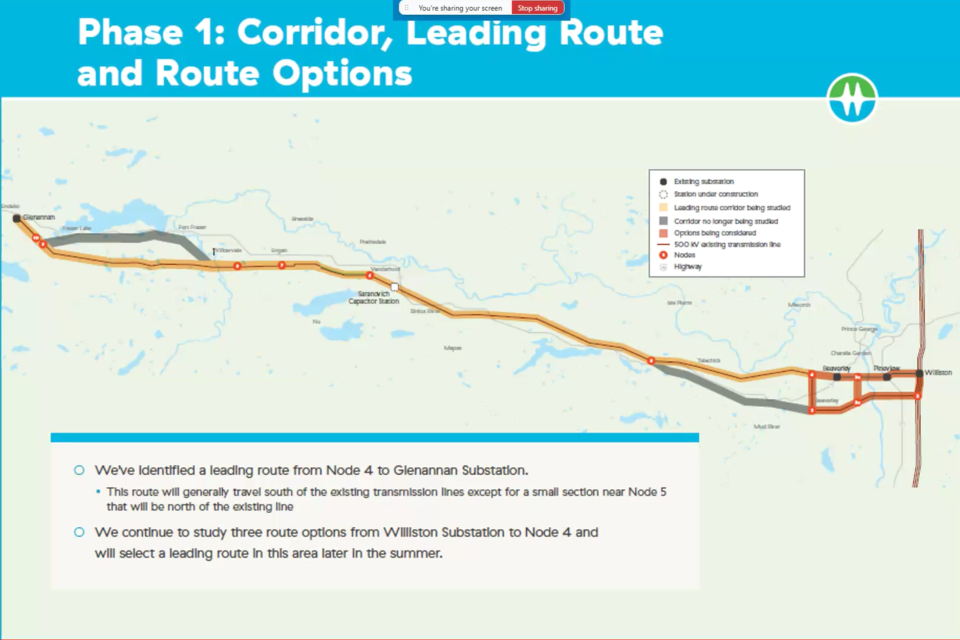Construction on the first phase of the North Coast Transmission Line expansion project, stretching from Prince George to the Glenannan substation, is expected to begin next summer, BC Hydro staff said during a virtual open house held Tuesday evening, June 24.
The online session marked the final in a series of nine open houses the Crown corporation hosted in June. In-person sessions were previously held in Prince George, Vanderhoof, Fraser Lake, Terrace, Smithers, Houston and Burns Lake.
The project, in development since 2023, will add a second 500-kilovolt transmission line. It will extend in two phases from the Williston substation, southeast of Prince George, to the Skeena substation near Terrace.
Future expansions could eventually extend the line to the Bob Quinn substation in northwestern B.C., to Prince Rupert and to the Minette substation near Kitimat.
During the open house, Hydro staff said the project aims to deliver more clean, reliable electricity to B.C.’s North Coast to support port operations, foster economic growth, reduce greenhouse gas emissions and meet growing demand.
As part of the project, BC Hydro and the province are also exploring opportunities for First Nations to not only be consulted, but to have a co-ownership stake.
The Lheidli T’enneh First Nation is among those consulted on Phase 1.
In total, 14 First Nations and eight Wet’suwet’en houses will be consulted. This process includes archaeological work and socio-economic impact assessments.
Phase 1 will see the construction of 170 kilometres of new transmission lines from the Williston substation to the Glenannan substation.
One presentation slide showed three potential routes from the Williston substation to a node west of Beaverly. From there, the lines would run south of the existing lines and Highway 16.
A previously considered route along Mud River is no longer under review, nor is a northern alternative that would have brought the line closer to Fraser Lake and Fort Fraser.
Phase 2 will add 130 kilometres of lines from Glenannan to the Telkwa substation, followed by 145 kilometres from Telkwa to the Skeena substation.
For the Glenannan-to-Telkwa route, the new line is proposed to run north of the existing one to avoid conflict with a 138-kilovolt line on the south side and to take advantage of an existing right-of-way.
Discussions with First Nations are ongoing for the Telkwa-to-Skeena section, particularly for the area between the Telkwa substation and the first node.
Between nodes one and two, the route is expected to follow Telkwa Pass along the current transmission path, pending further studies.
From the third to fourth node, the route would again follow the existing line while considering proximity to pipelines. Hydro has already worked with First Nations on this segment.
From the final node to the Skeena substation, the route would travel north of the current transmission line.
The Williston, Glenannan and Skeena substations will be expanded, while the Telkwa substation will be either upgraded or expanded. The Saranovich, Palling and Walcott capacitor stations will also be expanded. Fibre optic cable will be added to new and existing transmission structures.
Hydro staff said the project is divided into four stages: planning, design, pre-construction and construction.
The project is currently in the planning phase, which involves identifying route corridors, conducting a high-level environmental review, selecting a preferred route and completing early engineering and environmental studies.
Environmental fieldwork began last spring and continues in 2025. Wildlife studies run from May to August, fish and waterway studies in late May and June, vegetation studies from June to August, and archaeological work from May to September.
For new lines away from existing infrastructure, the right-of-way will be cleared to accommodate 10-year vegetation growth and potential tree falls from nearby forests.
Where new lines parallel existing ones, transmission structures will be built taller.
To accommodate the estimated 1,500 to 1,800 workers needed for construction, four temporary work camps are planned.
One camp near Fraser Lake will occupy 10 to 15 hectares and house 400 to 500 workers. Another, near the Telkwa substation, will be a similar size with capacity for 300 to 400 workers.
The other two camps, each between five and 10 hectares, will host 200 to 300 workers. One will be located between Telkwa and Telkwa Pass, and the other between Terrace and Telkwa Pass.
All four camps are expected to begin operations in 2027 and remain in place for three to four years.
In addition to these camps, BC Hydro said it intends to hire regional workers and contractors. More sites will be required for offices and laydown areas—temporary sites where construction materials and equipment are received and managed. These sites will require year-round road access, lighting, fencing, generators, portable washrooms, sanitary services, and heavy-truck and crane access.
First Nations will be eligible for direct procurement contracts on parts of the project, in addition to public tender opportunities.
Clearing and site access work, including helipad installation, is scheduled to begin in early 2026. Hiring will also begin that year.
Phase 1 is expected to be in service by fall 2030, and Phase 2 by mid-2032.
BC Hydro staff said materials from the open houses will likely be made available online the week after the final session.


